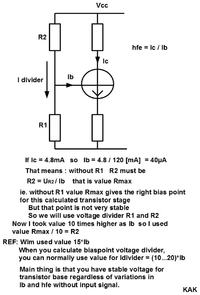ArFa
Junior Member level 2

Please can you tell me how to find these parameters: R1=? ; R2=? ; Re=?
if Vcc=18V; Rc=2k(ohm) ; IcQ=4.8 [mA] ; VceQ=6 [V] and beta = 120.
the circuit is:
**broken link removed**
if Vcc=18V; Rc=2k(ohm) ; IcQ=4.8 [mA] ; VceQ=6 [V] and beta = 120.
the circuit is:
Code:
http://img18.imageshack.us/i/electrocircuit.png/

